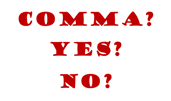 Has anyone ever told you that you should insert a comma into a sentence every time you take a breath as you read the sentence aloud? Most of us probably have. But that doesn’t mean it’s a grammar rule that should be widely accepted or slavishly followed.
Has anyone ever told you that you should insert a comma into a sentence every time you take a breath as you read the sentence aloud? Most of us probably have. But that doesn’t mean it’s a grammar rule that should be widely accepted or slavishly followed.
Below you’ll find more practical and grammatically validated information about comma usage.
Commas and Conjunctions
Commas should always be used when you’re using coordinating conjunctions to join two independent clauses in a sentence. FANBOYS (For, And, Nor, But, Or, Yet, So) is a helpful mnemonic device for remembering common coordinating conjunctions. Those words function as connectors in a sentence.
Example: He wanted to go to the movies, but I wanted to go out to dinner.
Note: Be aware of FANBOYS imposters that are commonly used in sentences, such as “however,” “therefore,” “moreover,” etc. Those words are conjunctive adverbs. Oftentimes when they’re used in between two independent clauses in a sentence, they can be removed to form two complete sentences instead. For example, consider this sentence: “The moon was bright, however, the forest still remained dark.” It can be changed to read: “The moon was bright. The forest still remained dark.”
Commas and Dependent Clauses
A dependent clause is a grammatical unit that contains both a subject and a verb but cannot stand on its own, because it doesn’t complete a thought or action, such as, “When I went to the fair.” Always insert a comma after a dependent clause that starts a sentence. However, you will not need to use a comma when a dependent clause ends a sentence, unless you are attempting to add emphasis, or when and if negation occurs.
Examples: When I left for work this morning, I forgot my wallet. I forgot my sneakers when I left for the gym.
Commas with Parenthetical Statements or Nonrestrictive Clauses
Sometimes you’ll want to insert extra information into a sentence, or a parenthetical statement, that isn’t essential to understanding it completely and what’s happening or being described in it. You’ll want to offset this information with commas or parentheses.
Example: Harper Lee, who wrote How to Kill a Mockingbird, won a Pulitzer Prize.
Commas for Introductory Adverbs
Use a comma after introductory adverbs in a sentence, such as “finally,” “unsurprisingly,” etc. Many adverbs end in "ly" and answer the question "how?" How did someone do something? How did something happen? And so on. Also use a comma after you begin a sentence with “yes” or “no.”
Example: Carefully, he inserted the pin to defuse the homemade bomb.
Commas and Appositives
An appositive is a word or phrase that refers to the same thing as another noun in the same sentence and acts like a synonym. If the appositive is necessary to the sentence, it’s said to be essential and it should not be surrounded with commas on either side of it. But if it’s not essential to the sentence, it should be accompanied by commas.
Example: I planted daffodils, a type of perennial flower, in my garden.
Commas and Negations in a Sentence
Use commas when negations occur at the end of a sentence.
Example: I like strawberry ice cream, not vanilla.
Commas and Coordinate Adjectives
Insert a comma between two adjectives that describe the same noun in a sentence, also known as coordinate adjectives. Two adjectives are considered “coordinate” if the sentence still makes sense when you rearrange the order of the adjectives in the sentence, or if you’re able to place “and” between the two adjectives without altering the sentence’s meaning.
Example: I saw the full, bright moon.
Commas When Directly Addressing Someone
When someone is being directly addressed in a sentence, his or her name should be separated by a comma.
Example: Wells, thanks for the birthday present. Take these tomatoes, Peggy.
Commas and Quotations
Always use commas when you’re directly quoting something that someone has said or written.
Example: Melanie said, “Fall is my favorite season of the year.”
Comma Splices
When you attempt to join two independent clauses with a comma but leave out the appropriate conjunction, this is called a “comma splice,” and it is grammatically incorrect. A comma alone can’t be used to join two independent clauses.
Example: Rick needed spices for the chili we were cooking, Margie ran out to the store to get them.
Commas for Dates, Titles, and Addresses
Here are examples for how to properly use commas in a sentence when you’re using dates, titles, and addresses.
Example for dates: I went to that Halloween party on October 27, 1983.
Example for titles: John Strong, a Marine Corps general, was laid to rest yesterday.
Example for addresses: She told me that she lived at 607 Commonwealth Avenue, Newton Centre, Massachusetts.
The Serial or Oxford Comma
Insert commas when listing a series of two or more items in a sentence, but be aware of the hotly debated serial comma, also known as the Oxford comma.
Example with serial comma: She has visited Beijing, Hong Kong, and Singapore.
Example without serial comma: She likes chocolate, strawberry and vanilla ice cream cake.
Note that here at ProofreadNOW.com, we always encourage using the serial comma. You’ll be consistently clear if you do. Here’s a sentence that really needs one:
For his late-night variety program, Bruce interviewed Caspian Stolinchya, a 50-year-old tattoo artist and an enterprising ex-convict. [You can see how unclear this sentence is without a comma after “artist.”]
***
What comma usage rule or rules do you always follow or have trouble following? Share with us in the comments below. And be sure to share this post with others who will also find it helpful.




